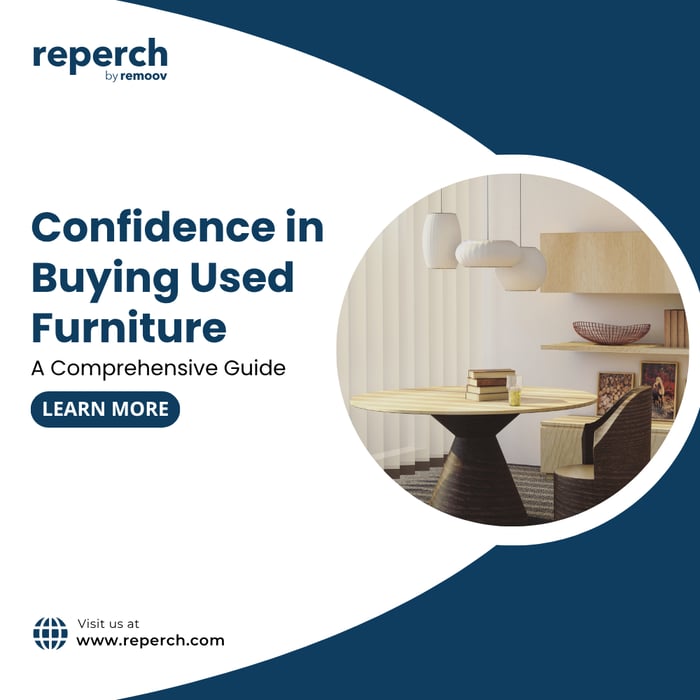Buying a secondhand couch is one of the smartest ways to save money while finding a stylish and comfortable piece for your home. But not all used couches are created equal. From checking for damage to evaluating materials and comfort, knowing what to look for can make the difference between a great deal and an expensive mistake.
Whether you're browsing Reperch or exploring local listings, this guide covers everything you need to know before saying yes to a secondhand sofa.
1. Check for Structural Damage First
Before you fall in love with a couch’s design, inspect its bones. Gently lift one end of the couch and give it a small shake. If it creaks, wobbles, or feels uneven, the frame may be compromised. A quality secondhand couch should feel solid, not flimsy.
Look underneath for hardwood framing, not particleboard or thin metal. Reinforced joints are also a good sign. If the couch includes a sleeper bed or recliner, test the mechanics. Make sure everything opens and closes smoothly.
Tip: Ask if the couch has ever had repairs. New staples or mismatched hardware might indicate a quick fix after a break.
2. Inspect Cushions and Upholstery Closely
Sit, lie down, and shift around. Do the cushions feel supportive? If they sink too much or are lumpy in spots, it could be a sign of worn-out foam or broken springs.
Next, check the upholstery. Look for rips, stains, and fading. Some flaws are purely cosmetic and can be cleaned or covered, but deep-set odors or fabric fraying are harder to fix. If the covers are removable, unzip them and look at the cushion filling. High-quality foam will bounce back instead of staying flattened.
Watch for warning signs:
Strong odors (mold, smoke, or pets)
Excessive discoloration
Pet hair embedded in seams
Pilling or rough texture
3. Ask About the Couch’s History
Understanding why a couch is being sold can give you peace of mind or raise red flags. If someone is moving and simply can’t take it with them, that’s a great find. If the seller avoids answering or gives vague replies, there could be damage they are hiding.
Whenever possible, ask:
How old is the couch?
Was it in a smoke-free, pet-free home?
Has it ever been professionally cleaned?
Why are they parting with it?
At Reperch, we take the guesswork out by inspecting, cleaning, and listing full condition reports on every couch. You’ll always know what you're getting before it arrives at your door.
4. Be Extra Cautious With Fabric Sofas
Fabric couches often show wear more clearly than leather. Stains, dust, and odors can settle deep into the fibers. If you're considering a fabric sofa, check the sitting area thoroughly. Look under cushions, around seams, and inside any folds or creases.
You can still score a great deal if the fabric is in good shape or the covers are machine washable. If the frame and cushions are excellent, you could even reupholster it or add a stylish slipcover to give it new life.
5. Choose Leather for Durability (but Inspect It Well)
Leather sofas hold up well over time and are resistant to most spills. That said, used leather couches can sometimes show cracks, dryness, or scratches especially if they were not regularly conditioned.
Gently press into the leather to see if it’s supple or stiff. Avoid any leather that flakes or peels, as that usually means the top layer has started to degrade. Look at high-use areas like armrests and seat corners for scuffs.
6. Don’t Forget to Measure Twice
The best couch in the world won’t help if it doesn’t fit your space. Measure the area where you plan to put it, including the width, depth, and height. Then double-check the path into your home: doorways, staircases, hallways, and tight corners.
Pro tip: Use painter’s tape to outline the couch dimensions on your floor before committing.
7. Give It a Comfort Test
Style is important, but comfort is everything. Sit in every spot on the couch. Stretch out like you would on a lazy Sunday. Ask yourself:
Is the seat depth right for lounging?
Is the back height supportive?
Are the armrests comfortable?
Sometimes a couch looks great in photos but just does not feel right when you sit on it. Trust your body.
8. Look for Signs of Pests or Infestations
Used furniture should always be checked for bed bugs or other pests. Look for tiny red or dark brown stains, especially around seams or folds. If you are buying from a private seller, inspect with a flashlight and don’t feel awkward doing it your peace of mind is worth it.
At Reperch, every couch is professionally inspected and cleaned, so you never have to worry about surprises hiding inside your new-to-you furniture.
9. Consider Cleaning and Refresh Options
Minor stains or smells should not stop you from scoring a great deal. Many used couches can be deep-cleaned at home using a handheld upholstery cleaner, baking soda, or steam.
If the covers are removable, toss them in the washer using a gentle detergent. For leather, a quality conditioner can work wonders. You can even dye or reupholster an older piece to match your space perfectly.
10. Buy From a Trusted Secondhand Source
When shopping for couches on resale marketplaces, you’ll often deal with strangers who might not disclose everything. That’s why platforms like Reperch take the stress out of secondhand shopping.
We inspect every couch, verify quality, clean it, and clearly list dimensions, materials, condition, and price. You can shop online or visit our showroom and trust that what you see is what you get.
Final Thoughts: Smart Shopping Means Smart Saving
Buying a secondhand couch can be a budget-friendly, sustainable way to upgrade your space. But the key is knowing what to look for. From inspecting the frame to testing comfort, checking upholstery, and asking the right questions, a little homework goes a long way.
At Reperch, we make it easy to shop confidently by curating only the best pre-loved couches. Whether you are furnishing your first apartment or giving your living room a refresh, we are here to help you find the perfect fit without the high price tag.
Browse our selection of secondhand couches today and find your next favorite seat.








